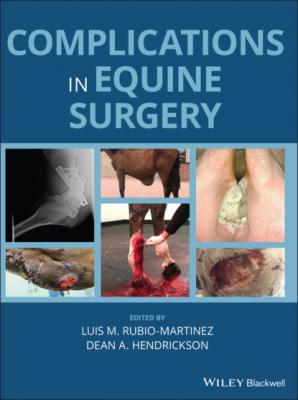Complications in Equine Surgery. Группа авторов
Читать онлайн.| Название | Complications in Equine Surgery |
|---|---|
| Автор произведения | Группа авторов |
| Жанр | Биология |
| Серия | |
| Издательство | Биология |
| Год выпуска | 0 |
| isbn | 9781119190158 |
Expected outcome
Use of an alternate site or replacement of the catheter usually resolves the problem. In some cases, hematoma, swelling, thrombophlebitis or infection at the site may develop.
Thrombophlebitis
Definition
Thrombophlebitis, defined as nonseptic or septic inflammation of the vein, is a common complication of indwelling intravascular catheters.
Risk factors
Related to catheter placement: technique, duration of catheterization, orientation of catheter relative to direction of blood flow, and material, length, and diameter of the catheter [1, 2, 4, 11]
Type of intravenous fluids or medications being administered (e.g. nonsterile fluids, hyperosmolar fluids (parenteral nutrition, 50% dextrose, hypertonic saline), undiluted irritating medications (chemotherapeutic agents, phenylbutazone, amphotericin B, etc.))
Patient‐related: critical illness, gastrointestinal disease, hypoproteinemia, and endotoxemia are independent risk factors for thrombophlebitis [11]. Patient colonization with methicillin resistant staphylococcus is an anecdotal risk factor.
Catheter materials ranked in order of decreasing risk of thrombosis are polypropylene > polyethylene > polytetrafluoroethylene > silicone rubber > nylon > polyvinyl chloride > polyurethane > silastic [1, 2, 4, 12].
Catheter size: Longer and larger diameter catheters are more inflammatory than short, narrow catheters [8, 12].
Catheter site handling: Catheter sites should be kept clean from environmental contamination, secured, and maintained with aseptic technique.
Pathogenesis
Development of thrombophlebitis is related to the inflammatory and pro‐coagulant environment present within the catheterized vessel [11]. Catheter‐related factors (type, duration, contamination, instability), patient‐related factors (concurrent disease, hypoproteinemia, endotoxemia, infection), and infusate characteristics (hyperosmolar, acidic, microparticulate) contribute to the degree of inflammation and coagulable state within the vessel. Bacterial colonization is not always associated with vascular changes [12, 13]; however, septic thrombophlebitis is a serious complication.
Prevention
Catheters should be placed and managed aseptically, adequately stabilized, and kept clean and protected from soiling or external trauma, with the caveat that daily inspection should continue despite protective wraps. Some clinicians advocate removal of all catheters after 48–72 hours and replacement in an alternate site if continued use is needed [12]; however, signs of thrombophlebitis can occur within 24 hours and repeated catheterization increases the risk of thrombophlebitis. Administration of low‐molecular weight heparin (dalteparin) in colic patients was associated with less subclinical (ultrasonographic) changes of thrombophlebitis than unfractionated heparin [14]. Non‐steroidal anti‐inflammatory treatment was found to be protective in another study [15]. Reduction in catheter flow may be caused by early development of a thrombus at the catheter tip.
Diagnosis
Catheter sites should be closely monitored on at least a daily basis for evidence of thickening or pain at the insertion site or along the catheter [1, 2, 4, 8]. Clinical signs of thrombophlebitis can occur within 24 hours and include thickening at the insertion sites, local swelling, heat, cord‐like thickening of the vein, suppurative exudate (Figure 3.1), pain on palpation, and if septic, may progress to fever, obtundation, and systemic signs associated with septic embolization to distant sites [1, 2, 4, 11]. Thrombophlebitis may also result in perivascular nerve injury, such as Horner’s syndrome and left laryngeal hemiplegia. If thrombophlebitis results in occlusion of venous drainage, associated veins may become dilated and tissues may become edematous (i.e. facial and nasal edema associated with jugular venous thrombosis) [1, 4, 16].
Monitoring
Ultrasound examination of the catheter site and associated vein is most sensitive to detect early signs of thrombophlebitis, such as thickening of the vein and development of a thrombus on the catheter (Figure 3.2) [1, 2, 4, 15]. The entire length of the catheter should be ultrasounded, because thrombi are often initiated at the distal tip. Ultrasonographic evidence of thickening of the vein is evident in at least 27% of catheterized veins maintained for at least 24 hours [15], although external clinical changes are seen in approximately 8–18% of colic patients [17, 18].
Figure 3.1 Photograph of a left jugular catheter insertion site associated with nodular thickening and suppurative exudate.
Source: Courtesy of Pablo Espinosa.
Figure 3.2 Transverse ultrasound image of the jugular vein shown in Figure 3.1. Hyperechoic material was identified superficial to the jugular vein (arrowhead). There was localized thickening (arrows) of the jugular vein wall (perivasculitis). The jugular vein remained patent.
Source: Courtesy of Pablo Espinosa.
Treatment
If there are any signs of thrombophlebitis, the catheter should be removed immediately and the catheter should be cultured or saved for culture if any concerns. Treatment should be instituted if there is local swelling, pain, or inflammation, and includes warm compresses and topical anti‐inflammatory treatment (dimethylsulfoxide or diclofenac). If signs of fever, suppurative discharge, or cellulitis are present, then systemic antimicrobial treatment is indicated and should be guided by culture and sensitivity results. If re‐catheterization is necessary, the affected vein must not be used and it is recommended to use another anatomic site (i.e. do not use contralateral jugular vein, if possible, because thrombophlebitis of both jugular veins can impede venous drainage from the head). If thrombophlebitis results in abscess formation or complete occlusion of the vein (Figure 3.3), it may be necessary to surgically
